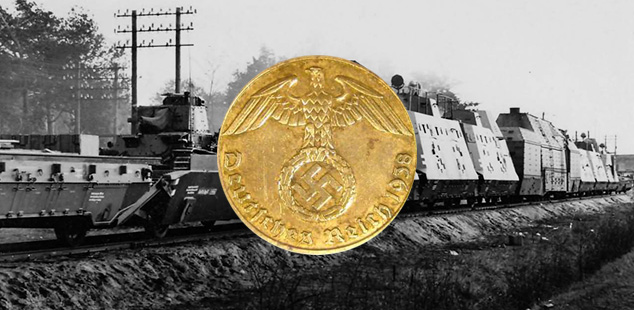
The news has been hopping the past few weeks with news of the possible discovery of the Nazi Gold Train 1. Though there’s a lot of excitement and speculation running wild, there are a lot of questions that still remain unanswered. What’s on the train? To whom does it legally belong? What should be done with the gold? These questions and more still remain to be answered.
What is the Nazi Gold Train?
The Nazi Gold Train was a small armored train between 100 and 150 meters in length believed to be carrying a large amount of precious metals, specifically gold, in addition to gems, weapons and various works of art including the Russian Amber Room. It was loaded up as the Soviet Red Army was closing in on the region, intended to ship to the town of Wroclaw, but it never showed up, leaving rampant speculation in the area that the train had been hidden. It was believed to hold up to 300 metric tons of treasure, art and weapons.
How was the location found and confirmed?
As the Third Reich was failing, Nazi prisoners were forced to dig over five miles of tunnels around the Polish Walbrzych district to house possible factories, military items and other items of value. After an alleged deathbed confession provided a “treasure map” that dictated the train’s location and a legal fight by two treasure hunters to guarantee themselves 10% of the find, Polish authorities brought ground-penetrating radar to the location to verify whether the train was actually in the tunnel. Supposedly, it is there and is over 100 meters in length. It’s expected that reaching and removing the items from the train may be a task fraught with danger, as the degraded explosives and booby traps may wreak havoc with the operation.
Who has rights to the contents?
It still remains to be seen what is actually on the train, but once the gold, jewels and art are excavated, there will be quite a controversy over what to do with the loot. There are several parties claiming the contents. The few survivors still alive, 70 years after the end of the war, certainly have top rights, and the Polish government is backing this claim. Poland itself is claiming anything else on the train, but Russia, who liberated Poland from the Nazis during WW2, is also staking a claim as reimbursement for military costs and specifically to any Russian art on the train, including the Amber Room, a Baroque-period room of amber panels, gold leaf and mirrors that vanished from St. Petersburg during the war. There are also a pair of treasure hunters, a Pole and a German, who are claiming 10% of the treasure for their discovery of it.
Perhaps the contents could be given to museums, such as in the case of $50,000 worth of Nazi gold coins also discovered recently by an archaeologist. Another possible solution is to look at the situation surrounding the Hungarian Gold Train. The 1946 Final Act of Paris Reparation Conference and Five-Power Agreement for Non-Repatriable Victims of Germany stated that any unclaimed or ownerless items should be sold and the money put into trust for refugees that could not be repatriated back into Germany. A similar tactic could be taken with this Gold Train.
Additional Sources:
